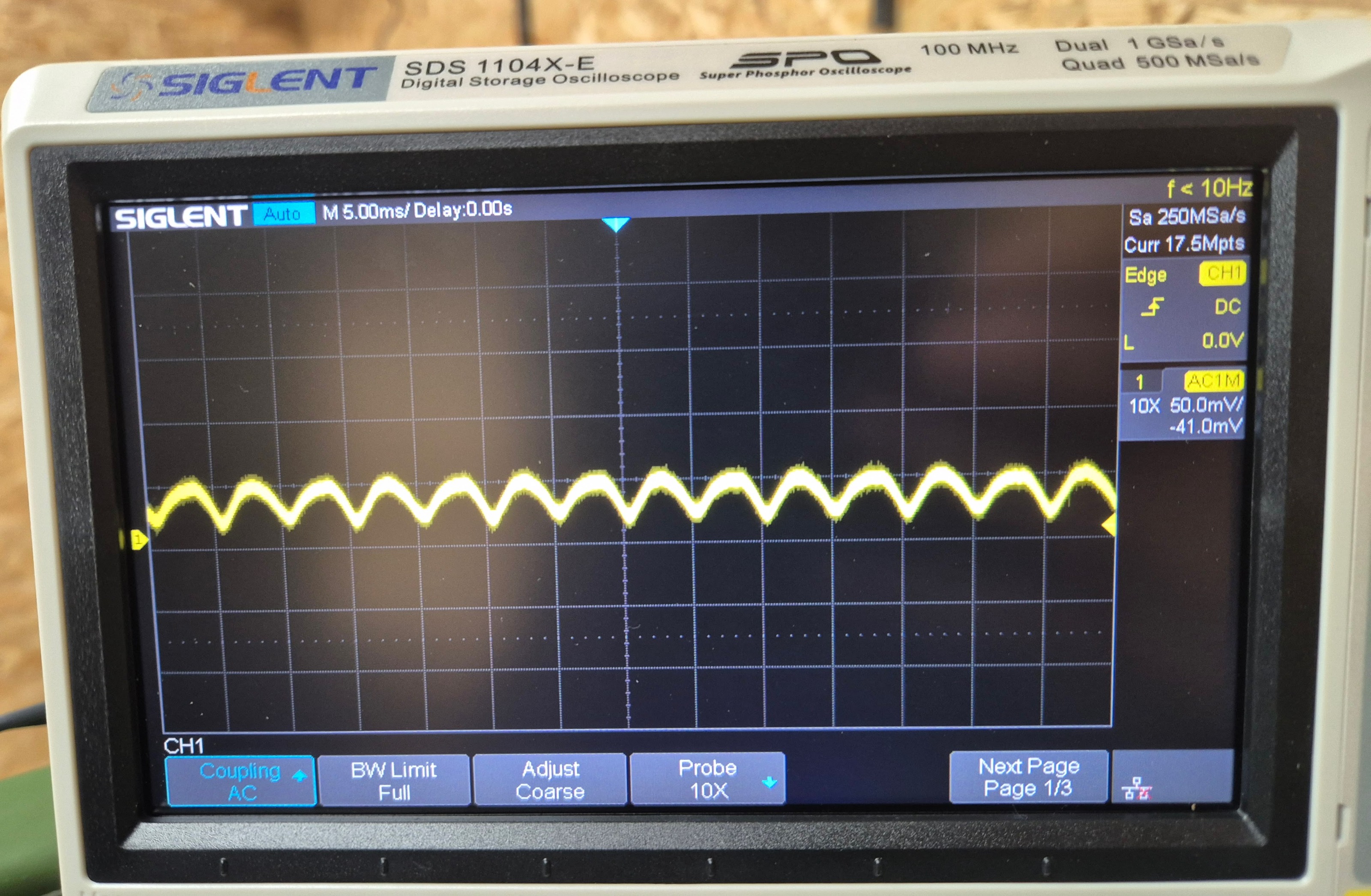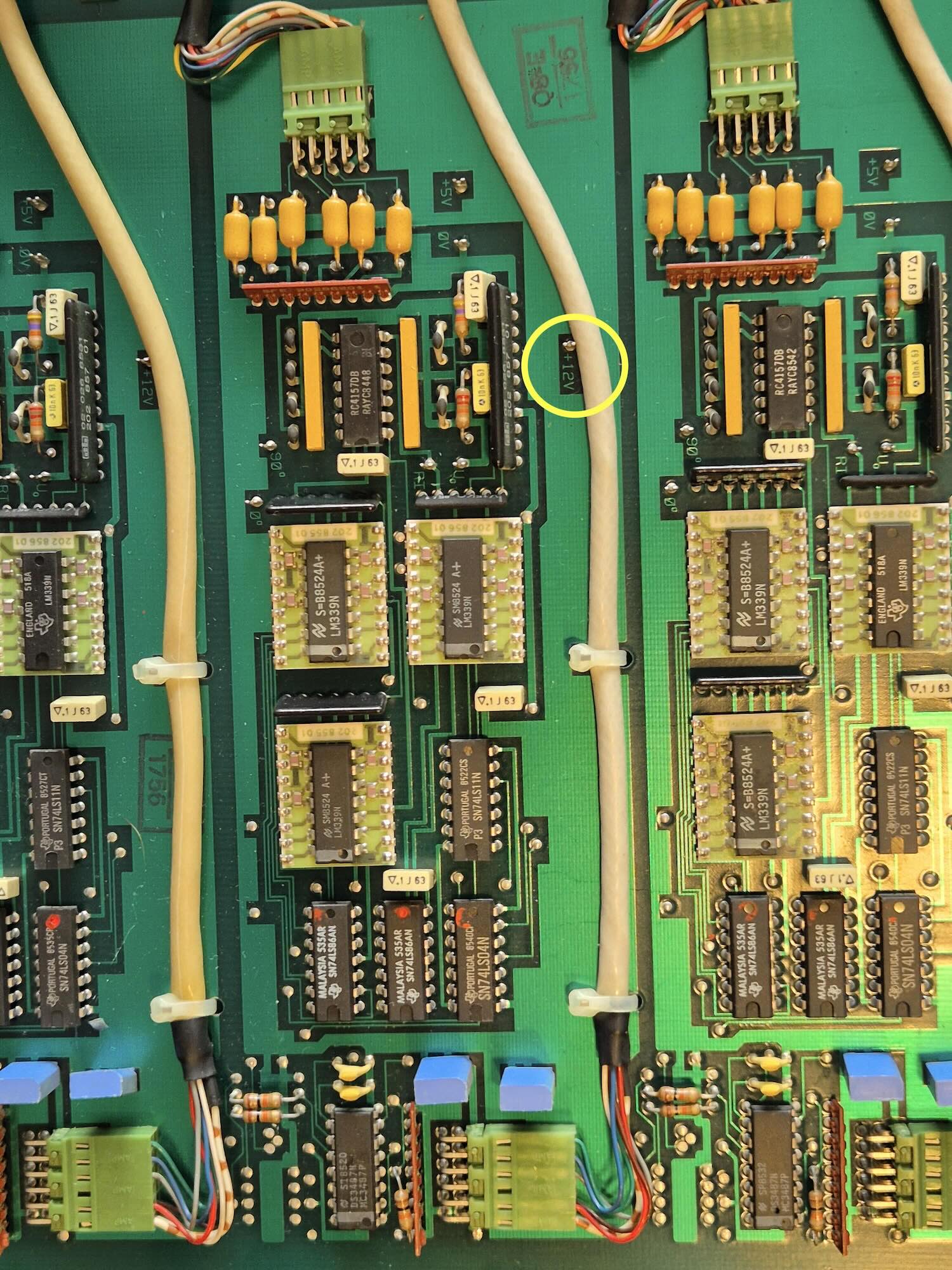- Hardware & Machines
- CNC Machines
- Milling Machines
- Trouble probing 1Vpp signal from Heidenhain LS403 with oscilloscope
Trouble probing 1Vpp signal from Heidenhain LS403 with oscilloscope
- workshop54
- Offline
- Junior Member
-

Less
More
- Posts: 30
- Thank you received: 3
29 Mar 2025 14:59 - 29 Mar 2025 15:05 #325250
by workshop54
Trouble probing 1Vpp signal from Heidenhain LS403 with oscilloscope was created by workshop54
Hi all,
I’m trying to troubleshoot a Heidenhain LS403 linear encoder (1Vpp analog output) that’s connected via a Heidenhain 1Vpp-to-TTL converter to a Mesa card in my LinuxCNC setup.
We weren’t seeing any motion or position data in HAL, so I decided to check whether the encoder is still producing valid analog signals.
I’m fairly new to working with encoders — and also still learning my way around the oscilloscope — so I might be missing something obvious. That said, here’s what I’ve done so far:
I’m trying to troubleshoot a Heidenhain LS403 linear encoder (1Vpp analog output) that’s connected via a Heidenhain 1Vpp-to-TTL converter to a Mesa card in my LinuxCNC setup.
We weren’t seeing any motion or position data in HAL, so I decided to check whether the encoder is still producing valid analog signals.
I’m fairly new to working with encoders — and also still learning my way around the oscilloscope — so I might be missing something obvious. That said, here’s what I’ve done so far:
- The encoder is powered via the Mesa card: 5 V and 0 V are confirmed and stable.
- For testing, the signal wires are disconnected from the Mesa. I’m only using it to supply power.
- Based on voltage levels and scope behavior while moving the encoder, I’ve identified A+, A–, B+, B–, R+, R–.
- When I probe A+ or B+ relative to 0 V, I see a flat ~2.0 V line. A– and B– show ~1.5 V. Moving the encoder slightly only causes minor fuzz — no visible sine wave.
- When I move the encoder head, the line does become “noisier” — in the sense that it gets visibly fuzzy — but I never see a clean sine wave.
- I also tried using two probes and a CH1 - CH2 math channel on a Siglent SDS1104X-E to simulate differential probing, but still no sine wave appears.
- I’ve played with timebase, voltage scale, trigger settings, etc., without much change.
At this point I’m unsure whether:- The encoder might be dead,
- The signal needs a specific load to show up properly,
- Or I’m simply not probing it correctly.
Any tips or guidance would be very welcome — especially from folks who’ve scoped Heidenhain 1Vpp encoders before. Thanks in advance!
Last edit: 29 Mar 2025 15:05 by workshop54. Reason: Add noise when moving encoder head
Please Log in or Create an account to join the conversation.
- HansU
-

- Offline
- Platinum Member
-

Less
More
- Posts: 697
- Thank you received: 212
29 Mar 2025 15:24 #325252
by HansU
Replied by HansU on topic Trouble probing 1Vpp signal from Heidenhain LS403 with oscilloscope
Just to make that sure - you can only measure a sine wave when you move the linear encoder homogeneously (approximately).
You can also measure the signal between A+ and A- with a multimeter - just move the linear encoder slowly.
Another possibility to "see something" is to measure a single signal and therefore switch the scope channel to AC coupling and choose 100mv/DIV or less.
You can also measure the signal between A+ and A- with a multimeter - just move the linear encoder slowly.
Another possibility to "see something" is to measure a single signal and therefore switch the scope channel to AC coupling and choose 100mv/DIV or less.
Please Log in or Create an account to join the conversation.
- workshop54
- Offline
- Junior Member
-

Less
More
- Posts: 30
- Thank you received: 3
29 Mar 2025 18:31 #325273
by workshop54
Replied by workshop54 on topic Trouble probing 1Vpp signal from Heidenhain LS403 with oscilloscope
Thanks for the quick reply — that already helped a lot!
I switched the scope channel to AC coupling and used a drill with an Allen bit to move the spindle. Now I can finally see a sine wave (kind of).
However, two things are still puzzling me:
Any idea what could be causing the “thick” waveform, and why the amplitude is so low?
I switched the scope channel to AC coupling and used a drill with an Allen bit to move the spindle. Now I can finally see a sine wave (kind of).
However, two things are still puzzling me:
- The sine wave appears very thick on the screen. My guess is it’s some kind of electrical noise, but I’m not entirely sure.
- The amplitude is only around 50 mV, which is way lower than the expected 1 Vpp.
Any idea what could be causing the “thick” waveform, and why the amplitude is so low?
Attachments:
Please Log in or Create an account to join the conversation.
- PCW
-

- Away
- Moderator
-

Less
More
- Posts: 17484
- Thank you received: 5109
29 Mar 2025 19:33 #325276
by PCW
Replied by PCW on topic Trouble probing 1Vpp signal from Heidenhain LS403 with oscilloscope
Yeah, that's not a sine wave (more like a rectified sine wave)
This may be something wrong with how you are measuring this
differentially (scope setup). Measuring single ended as Hansu suggested
would eliminate this possibility.
Is this connected to the converter? According to Heidenhains docs
the 1V P-P signals need a 120 Ohm (across 1V+ and 1V-) termination
The fuzzyness is likely just noise.
I suspect a problem with the encoder if you don't get ~1V sine waves when properly terminated
This may be something wrong with how you are measuring this
differentially (scope setup). Measuring single ended as Hansu suggested
would eliminate this possibility.
Is this connected to the converter? According to Heidenhains docs
the 1V P-P signals need a 120 Ohm (across 1V+ and 1V-) termination
The fuzzyness is likely just noise.
I suspect a problem with the encoder if you don't get ~1V sine waves when properly terminated
Please Log in or Create an account to join the conversation.
- HansU
-

- Offline
- Platinum Member
-

Less
More
- Posts: 697
- Thank you received: 212
29 Mar 2025 23:21 #325289
by HansU
This could be done with a differential probe, or you could power the encoder with a galvanic isolated power supply.
But that is not important now, I only wanted to check if there is a signal at all.
I think the low amplitude level is also ok. I have a Heidenhain rotary encoder and also some linear magnetic scales l worked with -- they all have a level much lower peak-peak value than 1V.
Replied by HansU on topic Trouble probing 1Vpp signal from Heidenhain LS403 with oscilloscope
Yeah you will probably get a sine wave when you measure it differentially.Yeah, that's not a sine wave (more like a rectified sine wave)
This could be done with a differential probe, or you could power the encoder with a galvanic isolated power supply.
But that is not important now, I only wanted to check if there is a signal at all.
I think the low amplitude level is also ok. I have a Heidenhain rotary encoder and also some linear magnetic scales l worked with -- they all have a level much lower peak-peak value than 1V.
Please Log in or Create an account to join the conversation.
- workshop54
- Offline
- Junior Member
-

Less
More
- Posts: 30
- Thank you received: 3
01 Apr 2025 19:38 - 01 Apr 2025 19:38 #325476
by workshop54
Replied by workshop54 on topic Trouble probing 1Vpp signal from Heidenhain LS403 with oscilloscope
Thanks for your reply, PCW.
I did some more measurements and I’m starting to learn a lot. It’s definitely a bit trickier working on a real machine compared to those nice clean test setups we often see on YouTube or datasheets
I noticed there’s a 12V pin on the board (right next to the white cable), but I originally assumed this was only used in other configurations. Now I’m starting to suspect it might actually be required for the board to function properly — possibly to power some signal conditioning or amplification circuitry.
Do you happen to know if this 12V input is normally used in setups with Mesa hardware? The 7i77 doesn’t provide 12V, so I’m wondering how this is usually handled. Is it common to add a separate 12V supply just for boards like this?
I haven’t applied 12V yet, since I don’t want to risk damaging anything.
Thanks again for the help!
I did some more measurements and I’m starting to learn a lot. It’s definitely a bit trickier working on a real machine compared to those nice clean test setups we often see on YouTube or datasheets
I noticed there’s a 12V pin on the board (right next to the white cable), but I originally assumed this was only used in other configurations. Now I’m starting to suspect it might actually be required for the board to function properly — possibly to power some signal conditioning or amplification circuitry.
Do you happen to know if this 12V input is normally used in setups with Mesa hardware? The 7i77 doesn’t provide 12V, so I’m wondering how this is usually handled. Is it common to add a separate 12V supply just for boards like this?
I haven’t applied 12V yet, since I don’t want to risk damaging anything.
Thanks again for the help!
Attachments:
Last edit: 01 Apr 2025 19:38 by workshop54.
Please Log in or Create an account to join the conversation.
- PCW
-

- Away
- Moderator
-

Less
More
- Posts: 17484
- Thank you received: 5109
01 Apr 2025 19:55 #325478
by PCW
Replied by PCW on topic Trouble probing 1Vpp signal from Heidenhain LS403 with oscilloscope
Yes, a missing power supply may be the issue
All 7I77 encoder circuitry is 5V, so you would
need a separate 12V supply.
Do you have the converter manual? it should show
the 12V connection.
All 7I77 encoder circuitry is 5V, so you would
need a separate 12V supply.
Do you have the converter manual? it should show
the 12V connection.
Please Log in or Create an account to join the conversation.
- workshop54
- Offline
- Junior Member
-

Less
More
- Posts: 30
- Thank you received: 3
04 Apr 2025 18:25 #325701
by workshop54
Replied by workshop54 on topic Trouble probing 1Vpp signal from Heidenhain LS403 with oscilloscope
Yes, the missing power supply was the issue. I was being too careful in my attempt not to blow up the Heidehain cards, but now it works.
I have hooked up all three encoders and for the first time I can see some movement in the LinuxCNC UI.
Thanks for your help again.
I have hooked up all three encoders and for the first time I can see some movement in the LinuxCNC UI.
Thanks for your help again.
Please Log in or Create an account to join the conversation.
- andypugh
-

- Offline
- Moderator
-

Less
More
- Posts: 19752
- Thank you received: 4584
04 Apr 2025 19:47 #325711
by andypugh
Replied by andypugh on topic Trouble probing 1Vpp signal from Heidenhain LS403 with oscilloscope
The 0V, 5V and 12V pins highlighted look like test points to me. I wouldn't expect them to be scattered about the board like that if they were power inputs.
Please Log in or Create an account to join the conversation.
- sivaraj
- Offline
- Senior Member
-

Less
More
- Posts: 48
- Thank you received: 23
09 Apr 2025 02:55 #325958
by sivaraj
Replied by sivaraj on topic Trouble probing 1Vpp signal from Heidenhain LS403 with oscilloscope
As for as I know Heidenhain LS403 is a 11uA signal . Not 1Vpp.
Please check the datasheet
Please check the datasheet
Please Log in or Create an account to join the conversation.
Moderators: piasdom
- Hardware & Machines
- CNC Machines
- Milling Machines
- Trouble probing 1Vpp signal from Heidenhain LS403 with oscilloscope
Time to create page: 0.187 seconds


